
The American Institute is where
I hatched most of these ideas.
I great language school!
Digression: What with my being one of this odd breed, my wife loaned me a book about one such TEFL teacher who set off to teach English in Tokyo: Tim Anderson's Tune In Tokyo:The Gaijin Diaries (2011). IT IS HILARIOUS! It's a wonderful read, and interesting to think about what problems the author faces which are the same in Spain, and which ones are really truly unique to teaching in Japan. It was therapeutic, too, since one's batteries can get drained trying to make classes animated when your students are, conversely, trying extra hard to be timid and not have to speak.
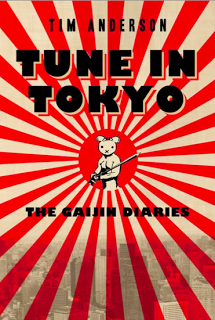
This is a must-read for anyone teaching
English as a second language. It is hilarious!
All of this is to say I'm still teaching English, and still getting ideas for ways to get students engaged in learning about the language _outside the classroom_. Here I'm posting a Part 2 entry where I share five more ready-made lessons that I've come up since my last post that I've found to be useful.
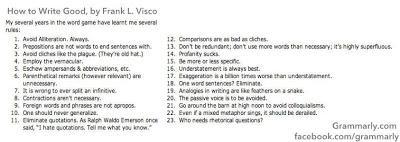
It doesn't hurt to review more general grammar rules with one's students.
I'm amazed at how quickly my students' grammar descends when they try to write in English,
as if the same rules they know for Spanish don't apply to foreign languages!
Before I dive into those, I have to share a couple of other resources I've learned about. First, one of the readers on my last post mentioned an interesting series of books that play with and have created a fake language: "fromlostiano". "Colín" (a.k.a. Federico López Socasau) and "Güéster" (a.k.a. Ignacio Ochoa Santamaría) have written a series of humorous glossaries —From lost to the river (1995) ("de perdidos al río"), Speaking in Silver (1999) ("hablando en plata"), and Shit yourself little parrot (2003) ("cágate lorito")— that play with literal Spanish-to-English translations (or really, lost in translation) of classic, colorful Spanish expressions, e.g. "for the face" ("por la cara"… for free, aprovechando). I'm not sure what the actual learning value is of these books would be, but they're good for getting laughs from Spaniards whose English is good, and maybe for English-speakers trying to remember common catchphrases in Spanish. (For those "tweeple" out there trying to learn Spanish, you can follow their tweets here: @fromlost; though a more useful resource on Twitter might be: @SpanishAddicts. Truly hilarious, the vocab they tweet!)
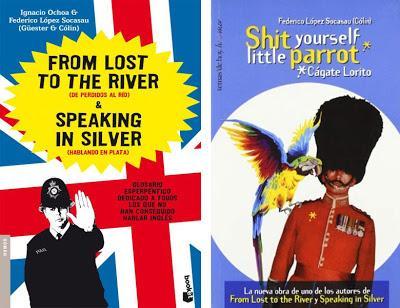
I guarantee you that if you just read these titles to your Spanish friend or partner,
you will hear them snicker. My wife, who had never heard of these books, couldn't
help laughing with each "fromlostiano" phrase that I read to her. Good stuff!
The second resource is local. A new shop opened up in Valencia, Rana Books, which I highly recommend to anyone in Valencia or who passes through who is interested in getting English-language books or learning materials. They have a fantastic collection, and they do workshops and special events that are great for Valencian parents who want their kids to get into learning English.
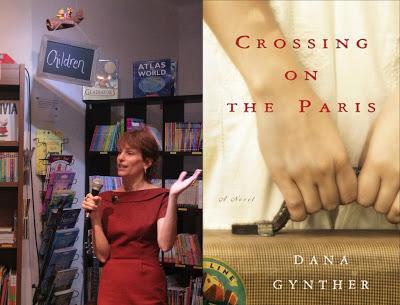
I finally got to visit Rana Books when a friend and co-worker did her book-release
party there. Here you can see my colleague, Dana Gynther, talking about her
new novel, Crossing on the Paris (2012), which was just published this past fall.
Look at what talented people work at the American Institute in Valencia!
Get a copy of her book and read it!
***Lesson 11: We Are Family – Family vocab and description practice***

Click here to load a PDF I made for reviewing family vocabulary.
Here's how I use the handout. Start with the questions on the handout: this gets them thinking about different sentence constructions to ask about relationships (i.e. practice using the genitive, a.k.a. apostrophe "s"): "He's ___'s sister". After going through the Simpsons family tree a bit, I then have the students brainstorm more relations they know: cousins, aunts/uncles, and so forth. Here I make a chart on the board: with prefixes on the left (grand-, great grand-, step, half-); roots in the middle (sister, mother/mom); and suffixes on the right (-in-law; -once-removed). I also talk about examples of neutral plural: siblings/parents (for brothers/sisters and mother/father). Or other less common relations: (fraternal/identical) twins; first/second cousin; "the in-laws". (I test their comprehension by asking: what's the difference between your stepbrother and half-brother; your mother-in-law and your stepmother; or your stepson and adopted son?)
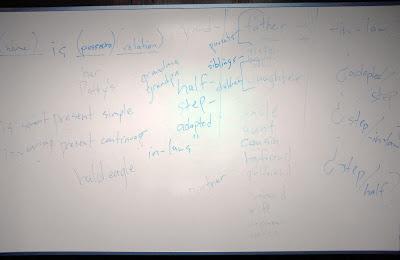
This was my board by the end of the brainstorm and diagramming of
family relations. Confessions: I have horrible handwriting!
Clarifications: "bald eagle" is on the board because I was trying
to make the link between "Homer is bald" and America's national emblem.
At this point, I have students look at the other side with the two pictures of the "Nuclear family" and the "Extended family". Here I ask student to describe someone in the photo: physical description ("Homer is bald"), personality ("Lisa is smart"), what they are doing ("watching TV"), and link it to explaining their relation to the rest of the family. While this lesson is particularly important for beginning and intermediate students, it didn't hurt when I did it with my advanced students, since describing the "Modern family", with all of their unconventional relations and personalities, was actually quite a challenge!
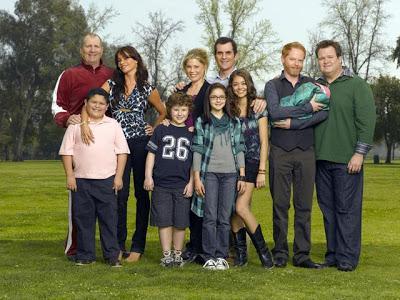
While some of my students knew this show, Modern Family was far from the
universally familiar Simpsons. So you might have to explain who is who,
which is why I include a family tree chart underneath this picture.
***Lesson 12: Myers-Briggs Personality Indicator – Personality vocab***
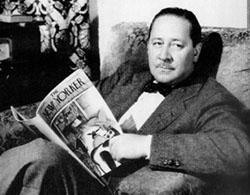
Robert Benchley had it right when he said:
"There are two kinds of people in the world:
those who divide the world into two kinds
of people, and those who don't."

To prepare the class for this exercise, I ask them about following scenario: You are the boss of a company and it is just before Christmas. You know that you have to layoff/fire some of your employees and you have to choose one of two options:
1) fire them before Xmas but give them a Xmas bonus, or
2) fire them after Xmas such that they continue to be paid over the holiday.
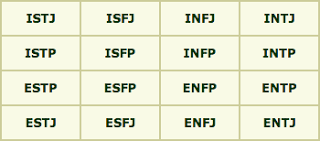
With four categories and two options each, there are
sixteen combinations of personality types in this test.
Click here to load a PDF I made of the Myers-Briggs personality type vocab.
Ask students what combination they think they would be, and then turn to the last two pages of the handout to discuss that type, and whether the description fits them. The descriptions have lots of personality vocabulary, so there is lots of opportunity to explain new words, and brainstorm synonyms. To encourage students to practice this vocabulary at home, tell them to find out what their "type" is by taking the test online at a site like this one: http://www.humanmetrics.com/cgi-win/JTypes1.htm.
Remember: The Myers-Briggs test is intended to be used therapeutically, to help people be aware of their natural biases and world views. There is no "correct" or true answer or "best" personality type, just differences that reveal how we think and reason, and what that says about our motivations and personalities.
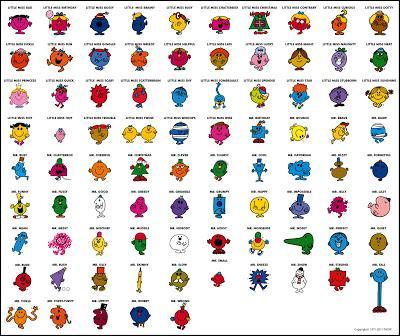
Of course, the ultimate reference on personality types, in my opinion,
continues to be "Mr. Men", cute and educational!
***Lesson 13: Thanksgiving – Holiday vocabulary, cross-cultural conversation***

As much as they denied it, I swear my students must have
seen at least one movie, like Miracle on 34th Street (1947),
or a Friends or Seinfeld episode that features the parade.
Thanksgiving has a lot of cultural elements to it, any of which you can use for discussion. Being a historian, I like to talk about the differences between the history and the myth-making surrounding the holiday. There is a lot of food vocabulary. There are also fun and funny cultural practices today: the Macy's Parade in NYC with the floats (I'm always shocked by how few Spaniards know anything about this); the holiday is an important movie-watching and/or football watching day (rivalry match-ups that I describe as like "el clásico" of American football); and the presidential pardon of one turkey on the Wednesday before, among other traditions.
I worked up three handouts for three different levels:
• Thanksgiving for Advanced (adult) learners:
This has a nice summary of the history and traditions of Thanksgiving with a lot of advanced vocabulary. It also includes a copy of the poem, "Over the River and Through the Wood", which by tradition was a Thanksgiving poem and song:
Click here to load a PDF I made for an advanced discussion of Thanksgiving.
• Thanksgiving for (Pre-)Intermediate (adult) learners:
This has a fill in the blank listening exercise which I got from the website, ESL Holiday Lessons:
Click here to load a PDF I made for an intermediate discussion of Thanksgiving.
Have students fill in the blanks as they listen to this recording:
Download this audio clip or click this link while in class, to play for your students.
• Thanksgiving for Kids
I composed this kids' activity from this "The First Thanksgiving Book" activity and activities on the ESOL Courses page for Thanksgiving. (An additional, optional activity is to print out the lyrics to "Over the River and Through the Woods", and sing along to the song with your students.):
Click here to load a PDF I made for discussing Thanksgiving with kids.
Thanksgiving also marks the beginning of Xmas holiday season, which means you can talk about holiday shopping and the tension between materialism and spiritual ideas about the holidays. (This year's Thanksgiving was a particularly juicy topic, what with the Black Friday controversy. Thanksgiving is also an opportunity to bring up cultural differences: for example, that Americans rarely have an extended (three-hour) meal with the family, in comparison to Spaniards. (The fourth week of November is an important week of recipe swapping in the States, too, which is why it is a good time to discuss cooking vocabulary. In my next post on English, I'm going to include a handout on cooking vocabulary, which you might use.)
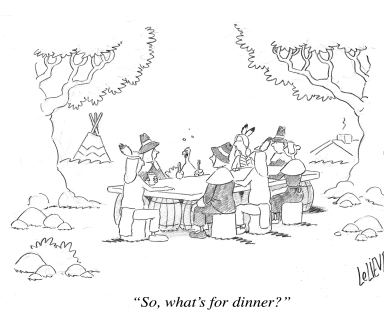
In addition to the non-Pilgrim-related traditions, I try to get across to my students
all the humor and playfulness that surrounds this uniquely American holiday.
***Lesson 14: The Oscars – Film vocabulary and passive voice***
I worked hard to have this lesson ready for early February because it's Oscars season!!! The Oscars, in my household, are a serious pastime, analogous to one's annual Super Bowl or el clásico. We try to watch as many nominated films as possible, and, yes, we do stay up here in Spain to watch them live. And one of our traditions it to guess which films will win which awards. So we each print out a ballot, make our bets as to who we think will (or ought to) win, and make a sport of it.
Perhaps for this reason, and because many of students expressed an interest in movies, and, well, also because film can be a useful topic for introducing certain issues (the passive voice, for example), this year I worked up a vocabulary handout with a lot of possible activities for you to do with your students on the topic of movies:
Click here to load a PDF I made of movie vocab plus the 2013 Oscars ballot.
For any of you readers who teach English in Spain, I highly recommend you do this lesson in mid February, in the weeks before the Goya Awards (February 17, 2013), Spain's main movie awards, and the Oscars, a.k.a. the Academy Awards (February 24, 2013). That way it's award season when you do the activities, and then you can have your students score their ballots and see how they did the following week. Nothing like a friendly wager to make an otherwise dull awards ceremony interesting. Oscars! Who will win this year? Exciting!

There is no easier and better ready-made lesson plan for language learning than to have your students listen to a carefully selected popular song and discuss the lyrics with them. Songs are a great way to: 1) introduce a lot of vernacular and slang vocabulary (we sing more like we speak, day-to-day), and 2) get them thinking about narration and how verb tenses are used to construct a story.
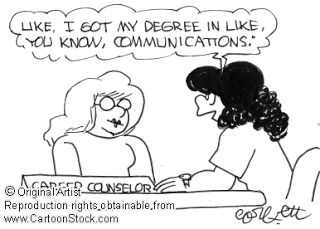
I can't, like, emphasize too much how, like, totally
important slang is for communication.
In addition to colorful expressions, the key is to find a song that tells a story and doesn't just repeat a chorus. (Unfortunately, this eliminates most Beatles songs.) And which introduces some topic (with relevant vocabulary) which you can use for conversation, or which illustrates some difficult kind of grammatical structure. Here's a (non-exhaustive) list of some songs that I've use to teach with, and why I chose them:
•
Narrative arc... 1) We Are the Champions, by Queen – from present perfect to present/future [Spaniards love this song, and yet often haven't paid attention to the lyrics] 2) My Way, by Frank Sinatra – from past to present to future 3) White Flag, by Dido – future predictions ("I will go down with this ship") • Specific grammatical constructions... 4) You Can Get It (If You Really Want), by Jimmy Cliff – modal verbs of possibility 5) Top of the World, by the Dixie Chicks – conditional to express regret ("I wished I'd a")• Specific vocabulary... 6) Say a Little Prayer, by Aretha Franklin – getting ready in the morning action verbs
* Doesn't hurt to make sure they've memorized the "Alphabet song", so that they can recall their ABCs!

The songs on this album by Lana del Rey are "chock full" of great one-liners
and classic code-switching references to Valleyspeak. My friend Chic Souffléwrote an entry (in Spanish) about it, with links to some of the more popular songs.
Once you've picked the song, simply download the lyrics, remove some choice words or phrases, and have the students listen to it once to "fill in the blanks". Then check with them what they got right/wrong, discuss the song, ask questions about what the song says/argues, discuss metaphors, phrasal verbs or idiomatic expressions used in it ("keep on fighting"), and then listen to the song again. (Though this time tell them to just listen, and not look at the lyrics.) Ideally, you should provide them a link to someplace online where they can listen to the song at home, so that they can do it on their own.
Eh, voilà! Instant 15-minute lesson, much more likely to teach them English-as-it-is-used than some dreary language book. Encourage them to take this practice home with them, to find songs that they like in English and practice studying the lyrics and their meaning. One of my students mentioned an incredible online tool to me when we did the Dictation exercise I developed last year (which I must boast is a _very_ popular exercise with my students): http://www.lyricstraining.com/. The site provides fill-in-the-blank lyrics which you type in as you listen to the song, and it adjusts for different language-levels. It is a great listening tool, and fun, too!
– – – I plan to continue this discussion of English-learning tools I've developed later in the
academic year, in a Part 3 post of "Five More Ready-Made Lessons". Until then,
I refer you back to my previous TEFL entry for further TEFl links and references – – –
